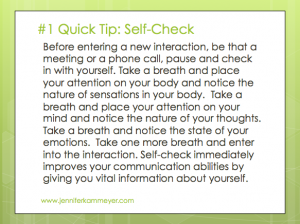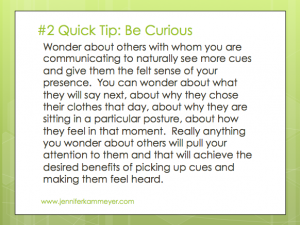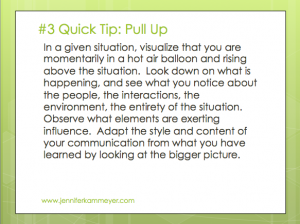Build Your Personal Brand: Make an impression through every communication interaction
A personal brand is the sum total of impressions that we make on other people. It is our image among the circle of people we wish to influence, be that our immediate team, our entire company, our industry, or an entire country. We create our brand through every single communication interaction. It is more than our online presence and media coverage. We create our brand through our body language, the words we choose to speak, and the manner in which we deliver our words.
Body language is a primary means of creating our personal brand because people judge us by our appearance within seconds of meeting us and nonverbal body communication is at least 50% of interpreted attitude meaning.1 There are the large movements of our body and the small gestures of our hands and face that influence in how people perceive us. The large movements include our position and posture, such as how close we are standing to others and whether we are leaning forward or leaning back. The small gestures include how we are using our hands and the movements of our muscles on our face. If we want our personal brand to exude power we will stand with our legs more than shoulder length apart, use grand hand gestures, and smile only occasionally. If it is receptiveness we want to be known for then we will keep our feet shoulder width apart, keep our hands open, and smile and nod frequently. After others get an initial impression from our body language, they focus on our words.
The words we select to communicate not only have meaning in and of themselves, but also in how we string them together. The audience we wish to influence has particular vernacular, and using words that have meaning to them allows us to have influence. The way we string words together can have very different effects on the audience. If we state ideas in no particular order and without intent, our ideas are not likely to cause an emotional reaction or be remembered. On the other hand, if we intentionally use rhetorical devices, such as alliterations and anaphora, we are more likely to engage both an emotional and a logical response from others. Alliteration is the repetition of the same sound, such as ‘common cause of catastrophe’. Anaphora is the repetition of the same word or phrase as the start of successive verses, such as ‘I have a dream’ in Martin Luther King’s famous speech.
While our focus is often on content, the style of our speaking is also important. Paralinguistics is the academic terms for our speech characteristics, which is everything except the words.2 This includes our pitch, tone, speed, and volume. American culture associates lower pitch with power and privileges those who speak louder and faster with a greater share of conversation time. Often we think of our style as just ‘being natural’ and forget that we actually have control and likely already vary our style for different audiences.
Knowing that every interaction builds personal brand, we can set intentions about our body language, word choice, and style in advance of each situation. Setting the intention, preparing, and practicing increases the probability that each situation builds personal brand in the way we wish to reach our professional goals.
Footnotes
- Mehrabian, A. & Ferris, S.R. (1967). Inference of Attitudes from Nonverbal Communication in Two Channels. Journal of Consulting Psychology, Vol 31(3), 248-252.
- Jaspers, J. M., Saager, P. G., Oever van den, T. (1973). Nonverbal Communication. Nederlands Tijdschrift voor de Psychologie en haar Grensgebieden, Vol. 28(1), 21-35.
Jennifer Kammeyer combines over 25 years of industry and academic experience to advise leaders on intentionally using communication to elevate professional relationships and improve business outcomes. She offers coaching one-on-one, in teams, and through workshops. As adjunct faculty at San Francisco State University, she is up to date on new communication research and trends, allowing her to counsel professionals on a wide range of communication topics. Popular training topics include building executive presence, leadership communication, public speaking, high-value meetings, and mindful communication. She has been personally practicing mindfulness since 1999 and incorporates these concepts into her teaching.



